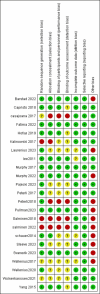Comparing Safety and Efficacy Outcomes of Gastric Bypass and Sleeve Gastrectomy in Patients With Type 2 Diabetes Mellitus: A Systematic Review and Meta-Analysis
- PMID: 38389648
- PMCID: PMC10883263
- DOI: 10.7759/cureus.52796
Comparing Safety and Efficacy Outcomes of Gastric Bypass and Sleeve Gastrectomy in Patients With Type 2 Diabetes Mellitus: A Systematic Review and Meta-Analysis
Abstract
Sleeve Gastrectomy (SG) could be done by the removal of a big portion of the stomach, leading to reduced amounts of food taken as a result of the smaller stomach size. In contrast, Roux-en-Y Gastric Bypass (RYGB) can be done by creating a small stomach pouch and rerouting a part of the small intestine, employing combined mechanisms of restriction and malabsorption to limit food intake and modify nutrient absorption. Our aim is to identify the most effective and safest surgical intervention for individuals with both Type 2 Diabetes Mellitus (T2DM) and obesity, considering both short and long-term outcomes. We will assess participants undergoing either SG or RYGB to determine the optimal surgical approach. We made a thorough search of PubMed, Cochrane Library, Scopus, and Web of Science databases up to November 2023. Our focus was on randomized controlled trials (RCTs) comparing the safety and efficacy of RYGB and SG in T2DM regarding any extractable data. We excluded studies of other designs, such as cohorts, case reports, case series, reviews, in vitro studies, postmortem analyses, and conference abstracts. Utilizing Review Manager 5.4, we performed a meta-analysis, combining risk ratios (RR) with a 95% confidence interval (CI) conducted for binary outcomes, while mean with SD and 95% CI are pooled for the continuous ones. The total number of participants in our study is 4,148 patients. Our analysis indicates superior outcomes in the group undergoing RYGB surgery compared to the SG group (RR = 0.76, 95% (CI) (0.66 to 0.88), P = 0.0002). The pooled data exhibited homogeneity (P = 0.51, I2 = 0%) after employing the leave-one-out method. For the 1-3 year period, six studies involving 332 patients with T2DM yielded non-significant results (RR = 0.83, 95% CI (0.66 to 1.06), P = 0.14) with homogeneity (P = 0.24, I2 = 28%). Conversely, the 5-10 year period, with six studies comprising 728 DM patients, demonstrated significant results (RR = 0.69, 95% CI (0.56 to 0.85), P = 0.14) and homogeneity (P = 0.84, I2 = 0%). In terms of total body weight loss, our findings indicate significantly higher weight loss with RYGB (mean difference (MD) = -6.13, 95% CI (-8.65 to -3.6), P > 0.00001). However, pooled data exhibited considerable heterogeneity (P > 0.00001, I2 = 93%). Subgroup analyses for the 1-3 year period (five studies, 364 DM patients) and 5-10 year period (six studies, 985 DM patients) also revealed significant differences favoring RYGB, with heterogeneity observed in both periods (1-3 years: P > 0.00001, I2 = 95%; 5-10 years: P = 0.001, I2 = 75%). RYGB demonstrated significant long-term improvement in diabetes remission and superior total body weight loss compared to SG. While no notable differences were observed in other efficacy outcomes, safety parameters require further investigation. no significant distinctions were found in any of the safety outcomes: hypertension (HTN), high-density lipoprotein (HDL), hyperlipidemia, fasting blood glucose, vomiting, low-density lipoprotein (LDL), and total cholesterol. Further research is essential to comprehensively assess safety outcomes for both surgical approaches.
Keywords: gastric bypass surgery; gastric sleeve surgery; systematic review and meta analysis; type2 diabetes mellitus; weight loss and obesity.
Copyright © 2024, Elsaigh et al.
Conflict of interest statement
The authors have declared that no competing interests exist.
Figures















References
-
- Overview of epidemiology and contribution of obesity to cardiovascular disease. Bastien M, Poirier P, Lemieux I, Després JP. Prog Cardiovasc Dis. 2014;56:369–381. - PubMed
Publication types
LinkOut - more resources
Full Text Sources
Research Materials
